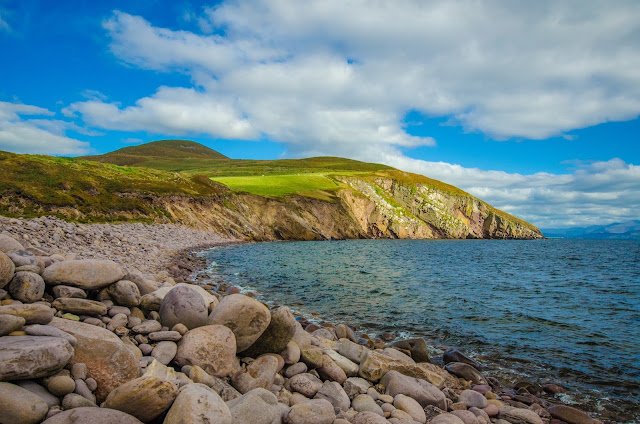 |
| The road to Tralee County Kerry, Dingle Peninsula |
We set up shop in the town of Dingle where we visited only five of the several dozen Irish Pubs where we enjoyed a Guinness or two, had some very fine meals, and were treated to traditional Irish music. We were told that there are 1300 full time residents in the town and that there are 500,000 sheep on the peninsula. We did see lots of sheep and yes there are many shades of green here.
 |
| The town of Dingle home to so many great pubs "sláinte" |
 |
| One of many sandy beaches on the Dingle Peninsula. |
 Our explorations took us by car along narrow country roads, so similar to those we enjoy here in Cumbria. We were surprised to find fuchsia growing wild along many of the roadsides. We learned that while this is not indigenous to Ireland it thrives here, and is welcomed for adding a bit of bright color to the landscape.
Our explorations took us by car along narrow country roads, so similar to those we enjoy here in Cumbria. We were surprised to find fuchsia growing wild along many of the roadsides. We learned that while this is not indigenous to Ireland it thrives here, and is welcomed for adding a bit of bright color to the landscape.
Off the beaten path we visited Kilmalkedar Church. The ancient monastery of Kilmalkedar was founded here in the 7th century. This Romanesque church building remains dating back to the 12th century. There are a number on ancient artifacts here including an Ogham stone inscribed with a hole at the top indicating it may have been used as a contract sone

Dingle holds on strongly to its irish identity. This region is a part of Gaeltacht, which is a region where the irish culture and language are preserved. The schools here conduct their lessons in Gaelic and the children often begin life with English as a second language. This has also been the site for a couple of Hollywood movies including the 1970 film, Ryan's Daughter.
We learned a bit about the history of the Dingle Peninsula, including a bit about the Great Potato Famine of 1845 when the population of Ireland was cut in half.
In the 6th century from this quiet bay a monk, St Bernard, is said to have set sail in a leather boat on his way to America. That would have put him in America well ahead of Christopher Columbus. There is a mountain named after him.
 The ruins of Min Aird Castle sit up on a bluff overlooking the sea and Storm Beach. The castle was attacked by Cromwell's Army in 1650. The castle was placed under siege which ended when explosive charges were set on each of the four corners causing structural damage that can still be easily seen today.
The ruins of Min Aird Castle sit up on a bluff overlooking the sea and Storm Beach. The castle was attacked by Cromwell's Army in 1650. The castle was placed under siege which ended when explosive charges were set on each of the four corners causing structural damage that can still be easily seen today.
 |
| Storm Beach is made up of very large surf worn boulders and the cliffs beyond. |
These "Beehive Huts" are sprinkled all over the countryside. They are believed to date back to medieval times when they served a variety of needs for shelter from a place for livestock to the family home. Some stand alone like this one and many are build in connected groups.
 |
| The locals kept a watchful eye on us... |
 |
| This is a view of Mount Brandon from the top of Conor pass. Really nice! |
Out in the middle of a farmer's field stands a really great ancient church. The Gallarus Oratory is a 1300 year old stone church. The stones are fitted dry with no mortar. The building remains in tact and is for the most part water tight. Very impressive craftsmanship.
 |
| Very dramatic scenery is everywhere. |
 |
| The sign says surfing lessons and indeed we did watch a group giving it a try. |










No comments:
Post a Comment